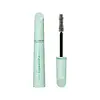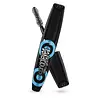Covergirl Lash Blast Cleantopia Mascara Versus Rimmel London ScandalEyes Retro Glam Waterproof Mascara
What's inside
What's inside
 Key Ingredients
Key Ingredients

 Benefits
Benefits

 Concerns
Concerns

 Ingredients Side-by-side
Ingredients Side-by-side

Water
Skin ConditioningParaffin
PerfumingStearic Acid
CleansingPvp
Emulsion StabilisingCetyl Alcohol
EmollientCera Microcristallina
Emulsion StabilisingHydrogenated Vegetable Oil
EmollientArginine
MaskingPolysorbate 20
EmulsifyingPropylene Glycol
HumectantRhus Verniciflua Peel Wax
Copernicia Cerifera Cera
Emollient2,3-Butanediol
HumectantStearyl Stearate
EmollientSynthetic Wax
AbrasivePanthenol
Skin ConditioningCandelilla Cera
EmollientCaprylyl Glycol
EmollientHectorite
AbsorbentSimethicone
EmollientSilica
AbrasiveTocopheryl Acetate
AntioxidantKaolin
AbrasivePantolactone
HumectantArgania Spinosa Kernel Oil
EmollientCamellia Sinensis Seed Oil
HumectantCellulose
AbsorbentPassiflora Edulis Seed Oil
EmollientRicinus Communis Seed Oil
MaskingSclerocarya Birrea Seed Oil
HumectantSimmondsia Chinensis Seed Oil
EmollientCocos Nucifera Oil
MaskingCaprylic/Capric Triglyceride
MaskingPersea Gratissima Oil
Skin ConditioningBiotin
AntiseborrhoeicCeramide Ng
Skin ConditioningChamomilla Recutita Flower Extract
MaskingCucumis Sativus Fruit Extract
EmollientAloe Barbadensis Leaf Extract
EmollientTocopherol
AntioxidantIron Oxides
CI 77007
Cosmetic ColorantWater, Paraffin, Stearic Acid, Pvp, Cetyl Alcohol, Cera Microcristallina, Hydrogenated Vegetable Oil, Arginine, Polysorbate 20, Propylene Glycol, Rhus Verniciflua Peel Wax, Copernicia Cerifera Cera, 2,3-Butanediol, Stearyl Stearate, Synthetic Wax, Panthenol, Candelilla Cera, Caprylyl Glycol, Hectorite, Simethicone, Silica, Tocopheryl Acetate, Kaolin, Pantolactone, Argania Spinosa Kernel Oil, Camellia Sinensis Seed Oil, Cellulose, Passiflora Edulis Seed Oil, Ricinus Communis Seed Oil, Sclerocarya Birrea Seed Oil, Simmondsia Chinensis Seed Oil, Cocos Nucifera Oil, Caprylic/Capric Triglyceride, Persea Gratissima Oil, Biotin, Ceramide Ng, Chamomilla Recutita Flower Extract, Cucumis Sativus Fruit Extract, Aloe Barbadensis Leaf Extract, Tocopherol, Iron Oxides, CI 77007
Water
Skin ConditioningParaffin
PerfumingGlyceryl Stearate
EmollientCopernicia Cerifera Cera
EmollientPvp
Emulsion StabilisingCera Alba
EmollientPropylene Glycol
HumectantTribehenin
EmollientPolysorbate 20
EmulsifyingStearic Acid
CleansingAmmonium Acrylates Copolymer
Panthenol
Skin ConditioningCaprylyl Glycol
EmollientHydroxyethylcellulose
Emulsion StabilisingTocopheryl Acetate
AntioxidantSodium Hydroxide
BufferingTalc
AbrasiveAcrylates/Carbamate Copolymer
Skin ConditioningAscorbyl Glucoside
AntioxidantGossypium Herbaceum Powder
AbsorbentSerica Powder
Skin ConditioningRetinyl Palmitate
Skin ConditioningHydrogenated Vegetable Oil
EmollientGlycerin
HumectantCollagen
MoisturisingHydrogenated Olive Oil
Skin ConditioningOlea Europaea Fruit Oil
MaskingHydrolyzed Keratin
HumectantPrunus Armeniaca Kernel Oil
MaskingSodium Sulfate
Ceramide Ns
Skin ConditioningOlea Europaea Oil Unsaponifiables
Skin ConditioningPotassium Sorbate
PreservativePhenoxyethanol
PreservativeBambusa Arundinacea Leaf Extract
Skin ConditioningSodium Benzoate
MaskingTocopherol
AntioxidantCI 75470
Cosmetic ColorantCI 77289
Cosmetic ColorantCI 77288
Cosmetic ColorantCI 77510
Cosmetic ColorantIron Oxides
Mica
Cosmetic ColorantCI 77891
Cosmetic ColorantCI 77007
Cosmetic ColorantWater, Paraffin, Glyceryl Stearate, Copernicia Cerifera Cera, Pvp, Cera Alba, Propylene Glycol, Tribehenin, Polysorbate 20, Stearic Acid, Ammonium Acrylates Copolymer, Panthenol, Caprylyl Glycol, Hydroxyethylcellulose, Tocopheryl Acetate, Sodium Hydroxide, Talc, Acrylates/Carbamate Copolymer, Ascorbyl Glucoside, Gossypium Herbaceum Powder, Serica Powder, Retinyl Palmitate, Hydrogenated Vegetable Oil, Glycerin, Collagen, Hydrogenated Olive Oil, Olea Europaea Fruit Oil, Hydrolyzed Keratin, Prunus Armeniaca Kernel Oil, Sodium Sulfate, Ceramide Ns, Olea Europaea Oil Unsaponifiables, Potassium Sorbate, Phenoxyethanol, Bambusa Arundinacea Leaf Extract, Sodium Benzoate, Tocopherol, CI 75470, CI 77289, CI 77288, CI 77510, Iron Oxides, Mica, CI 77891, CI 77007
 Reviews
Reviews

Ingredients Explained
These ingredients are found in both products.
Ingredients higher up in an ingredient list are typically present in a larger amount.
Caprylyl Glycol is a humectant and emollient, meaning it attracts and preserves moisture.
It is a common ingredient in many products, especially those designed to hydrate skin. The primary benefits are retaining moisture, skin softening, and promoting a healthy skin barrier.
Though Caprylyl Glycol is an alcohol derived from fatty acids, it is not the kind that can dry out skin.
This ingredient is also used as a preservative to extend the life of products. It has slight antimicrobial properties.
Learn more about Caprylyl GlycolThis pigment is called Ultramarine blue lazurite. It gives a saturated blue color, but can be used to create other colors as well.
According to the manufacturer, it is usually made from kaolin, sodium sulfate, sodium carbonate, sulfur, and charcoal.
This ingredient comes from a palm tree native to Brazil. This ingredient is used to thicken texture and leaves behind a film when applied.
Hydrogenated Vegetable Oil is created by adding hydrogen to vegetable oil in order to give it more stability. This process also raises the melting point of vegetable oil. In cosmetics, it is an emollient.
Emollients help soothe and soften the skin. They do this by creating a protective film on your skin. This barrier helps trap moisture and keeps your skin hydrated. Emollients may be effective at treating dry or itchy skin.
The term "Hydrogenated Vegetable Oil" is an umbrella term and can refer to a variety of vegetable oils and blends of: sunflower oil, soybean oil, olive oil, coconut oil, palm oil, and more.
Due to the differences in vegetables, the benefits may vary.
Learn more about Hydrogenated Vegetable OilPanthenol is a common ingredient that helps hydrate and soothe the skin. It is found naturally in our skin and hair.
There are two forms of panthenol: D and L.
D-panthenol is also known as dexpanthenol. Most cosmetics use dexpanthenol or a mixture of D and L-panthenol.
Panthenol is famous due to its ability to go deeper into the skin's layers. Using this ingredient has numerous pros (and no cons):
Like hyaluronic acid, panthenol is a humectant. Humectants are able to bind and hold large amounts of water to keep skin hydrated.
This ingredient works well for wound healing. It works by increasing tissue in the wound and helps close open wounds.
Once oxidized, panthenol converts to pantothenic acid. Panthothenic acid is found in all living cells.
This ingredient is also referred to as pro-vitamin B5.
Learn more about PanthenolParaffin is a solid created from petroleum. The term 'paraffin' can also refer to either
petroleum jelly or mineral oil.
It has natural occlusive properties which can worsen oily skin. Due to its petrolatum base, this ingredient is not fungal-acne safe.
Polysorbate 20 is made by combining ethoxylation of sorbitan, ethylene oxide, and lauric acid. It is a mild cleansing agent, surfactant, and emulsifier.
As a surfactant, it helps collect dirt and oils for washing. Emulsifiers prevent oils and water from separating.
Polysorbate 20 also adds scent to a product. Since it is made using sorbitol, it has a sweet scent. Sorbitol can also be found in fruits such as apples and peaches.
The lauric acid used to create Polysorbate 20 is often derived from coconuts.
Polysorbate 20 may not be fungal acne safe.
Learn more about Polysorbate 20Propylene Glycol is an odorless, colorless liquid. As a humectant, it helps skin retain moisture. It also aids in delivering active ingredients.
Another role of this ingredient is preventing a product from melting or freezing. Propylene glycol also adds antimicrobrial properties to a product, elongating product lifespan.
This ingredient is considered an organic alcohol and commonly added into both cosmetics and foods.
Those with sensitive skin or conditions may develop a rash when using this ingredient.
Learn more about Propylene GlycolPvp is a water-soluble synthetic polymer and common hairstyling ingredient. It is a film-forming ingredient and used to "hold" specific shapes of hair.
Pvp is less effective in high-humidity. It tends to draw moisture, but this moisture dismantles the structure and "hold".
Stearic Acid is a fatty acid. It is an emollient, emulsifier, and texture enhancer.
As an emollient, stearic acid helps soften skin. It aids the skin's protective barrier by preventing water loss. It also provides a gentle cleansing effect without stripping away natural oils.
Stearic acid may also be used to enhance the texture of products. It can add volume and stabilize ingredients such as water and oil. This can help water and oil ingredients from separating.
Sources of stearic acid include animal or vegetable fats/oils such as coconut or shea. It can be naturally found in butter, cocoa butter, shea butter, vegetable fats, and animal tallow.
This ingredient may not be Malassezia folliculitis, or fungal-acne safe.
Learn more about Stearic AcidTocopherol (also known as Vitamin E) is a common antioxidant used to help protect the skin from free-radicals and strengthen the skin barrier. It's also fat soluble - this means our skin is great at absorbing it.
Vitamin E also helps keep your natural skin lipids healthy. Your lipid skin barrier naturally consists of lipids, ceramides, and fatty acids. Vitamin E offers extra protection for your skin’s lipid barrier, keeping your skin healthy and nourished.
Another benefit is a bit of UV protection. Vitamin E helps reduce the damage caused by UVB rays. (It should not replace your sunscreen). Combining it with Vitamin C can decrease sunburned cells and hyperpigmentation after UV exposure.
You might have noticed Vitamin E + C often paired together. This is because it is great at stabilizing Vitamin C. Using the two together helps increase the effectiveness of both ingredients.
There are often claims that Vitamin E can reduce/prevent scarring, but these claims haven't been confirmed by scientific research.
Learn more about TocopherolTocopheryl Acetate is AKA Vitamin E. It is an antioxidant and protects your skin from free radicals. Free radicals damage the skin by breaking down collagen.
One study found using Tocopheryl Acetate with Vitamin C decreased the number of sunburned cells.
Tocopheryl Acetate is commonly found in both skincare and dietary supplements.
Learn more about Tocopheryl AcetateWater. It's the most common cosmetic ingredient of all. You'll usually see it at the top of ingredient lists, meaning that it makes up the largest part of the product.
So why is it so popular? Water most often acts as a solvent - this means that it helps dissolve other ingredients into the formulation.
You'll also recognize water as that liquid we all need to stay alive. If you see this, drink a glass of water. Stay hydrated!
Learn more about WaterThis ingredient is a combination of red, black, and yellow iron oxide pigments. This combination of colors is usually found in foundation, because it results in a "skin" color.